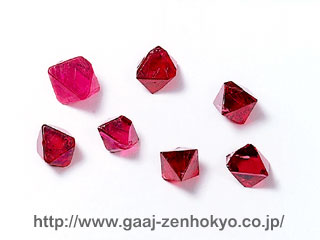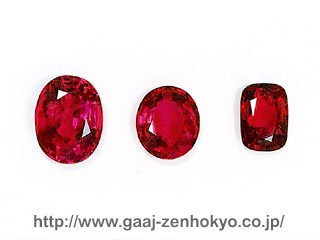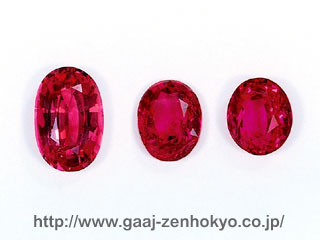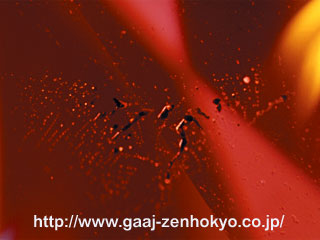|
|||||||||||||||||||||||||||||||||||
|
Natural spinel in red to pink colour brought in our laboratory for identification is increasing. One of the reasons will be that spinel generally has not been heated while most of corundum in similar colour have been heat-treated to improve their colour. However, synthetic spinel that is difficult to detect can be mixed with natural stones and care should be taken.
Background and gemmological feature of natural and synthetic spinel are introduced here. Spinel was named after a Latin word gspinah that means a small spine. It was derived from the sharp form of the crystal, and its Japanese name also originats in this character. Common crystal form of spinel is not acicular like spines but an octahedron with sharp corners. If a crystal has not been abraded and remains its ideal form, it is called gangel cuth and may be used for jewellery as rough. Broadly defined chemical composition of spinel is expressed as X2+Y3+2O4. X may be filled with divalent elements such as Mg, Mn, Fe, Zn, Co or Cu, and so may Y with trivalent elements such as Al, Fe3+ or Cr, to form a complex solid solution. Narrowly defined spinel has a chemical composition MgAl2O4, to which most of gem spinel belongs. Spinel for gem use has varieties in each colour, and they can be divided roughly into two groups of red and blue. Blue series can be created by Fe partly replacing Mg, and so can red series by Cr partly replacing Al. Spinel has been often confused with corundum until 18th century. Red spinel and blue spinel have similar appearance and gemmological properties to ruby and sapphire respectively, and one main reason of their confusion is that both gem species are in paragenetic relation so that they occur in the same locality. If a stone shows a perfect crystal form, distinction can be clearly made, as spinel shows octahedron form of cubic system, while corundum shows hexagonal scalenohedron or barrel shape of trigonal crystal system. However, if a stone is a pebble that shows no original form such as the one found in the secondary deposit, the distinction becomes difficult. It is a famous story that the ruby of Black Prince set in the Crown of British royal family turned out to be a spinel. @@Recently, identification request for red and pink spinel is increasing at our laboratory. Mr. Minoru KAMEYAMA of MIYUKI Co. Ltd., says spinel is a hot item in current market. He explains that recent popularity of this material is partly derived from publicfs preference for gnaturalh, because most of ruby and sapphire have been heat treated for colour improvement but spinel is generally unheated. According to a gem dealer Mr. SudhanshuVerma, red spinel from Mogok mine in Myanmar shows deep hue similar to ruby (as shown photo 1 and 2), and many from Nam-ya mine show bright hue (as shown photo 3). Output of red series spinel from these mines is less than ruby and thus the material becomes a rarity.
As its popularity rises and demand increases, distinction of natural spinel from synthetic inevitably becomes in focus. Flux synthetic spinel was produced by chance during a synthesis of corundum in the middle of 1800s, but it had not been used commercially until about 1989. Up to today, flux synthetic spinel of blue and red made in Russia has been on the market. This synthetic spinel has gemmological properties perfectly overlapping with those of natural and the material is one of the most difficult gemstones to identify. Shown in the photo 4 is a flux synthetic red spinel weighing 3.31ct we recently studied for identification. The owner of the stone said the stone was sold as a natural spinel from Vietnam. @@RI and SG of the stone was 1.715 and 3.59 respectively, and it showed bright red fluorescence under both LWUV and SWUV. Chrome lines were recognised with a handy-type spectroscope, but organ pipes (emission lines) characteristically seen in natural red spinel were not observed. Under magnification, liquid-like inclusion reminding of natural spinel at a glance is observed, but it turns out to be metal-flux under further observation with strong fibreoptic light (as shown photo 5).
A flux reaching to the polished surface was analysed by X-ray fluorescence spectrometry, which revealed that it was composed mainly of Pb and V (as shown fig-1). Photoluminescence analysis using 514nm argon ion laser showed a spectral pattern not corresponding to organ pipes seen in natural red spinel (as shown fig -2).
|











